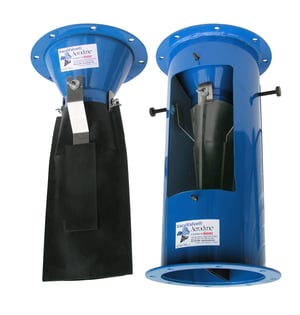All dry dust collectors have a hopper which temporarily collects the dust while it is moved out of the system. The hopper usually has a flanged outlet on bottom which allows the dust to fall outside of the dust collector vessel. When you are deciding what to put under the hopper it is important to make sure that air doesn’t flow out of or into the opening while still allowing the dust to empty from the hopper. An airlock (discharge valve) is used to prevent this.
An airlock comes in a variety of designs. The most common is the rotary airlock while the simplest design is a trickle valve (Aerodyne Vacu-Valve). What these valves do is prevent the higher pressure air from going to the lower pressure air. Generally dust collectors are designed to be under vacuum. This prevents dust from escaping the vessel and helps protect the exhaust fan from being damaged by dust loading. However, some systems do have pressured dust collectors for operational reasons. Either way it is important that there be some kind of airlock under the hopper.
Dust Collector Under Pressure
A pressurized dust collector will blow air out of the hopper if no airlock is installed on the hopper. This will create a dust cloud around the dust collector. If indoors this will coat the surrounding equipment and become a nuisance to employees in the area. Plus it’s pretty unseemly having a dust collector spewing dust out in a facility.
Dust Collectors Under Vacuum
A system under vacuum, however, is much more impacted by not having an airlock. The airlock prevents outside air from entering the system. So if you don’t have an airlock the exhaust fan will begin pulling air into the system through the hopper. This does two main things. For one, it lowers the airflow at the pickup points that are collecting the dust. Air will flow the easiest path (much like water). So if you have an opening allowing air to enter through the hopper then air will take advantage of this. And since your exhaust fan doesn’t care where the air comes from it will pull much of the air through the hopper. This airflow means that there will be less air coming from the pickup points. This could cause insufficient dust pickup at those points and even dust buildup in the ductwork. The second issue is that any dust collected in the hopper could get re-entrained by the air entering through the hopper outlet and then leave the dust collector. This will decrease the system removal efficiency and could cause violations of permits, increased fan maintenance, etc.
So when you are operating a dust collection system, make sure that the dust discharge flange is installed with an airlock, that way you will have the system operating at its peak efficiency.
How Do Vacu-Valve Dust Valves Work?
To learn more about which dust collector, please contact our experts at 440-543-7400 or visit our website: www.dustcollectorhq.com.
To improve efficiency and safety, there is no substitute for an on-site inspection by an experienced expert. Click below to start with a free 20-minute phone consultation by clicking the button.

